Purple flowers: 16 eye-catching blooms for instant impact
If you love purple flowers, include these stunning options in your planting scheme for decadent, bold borders
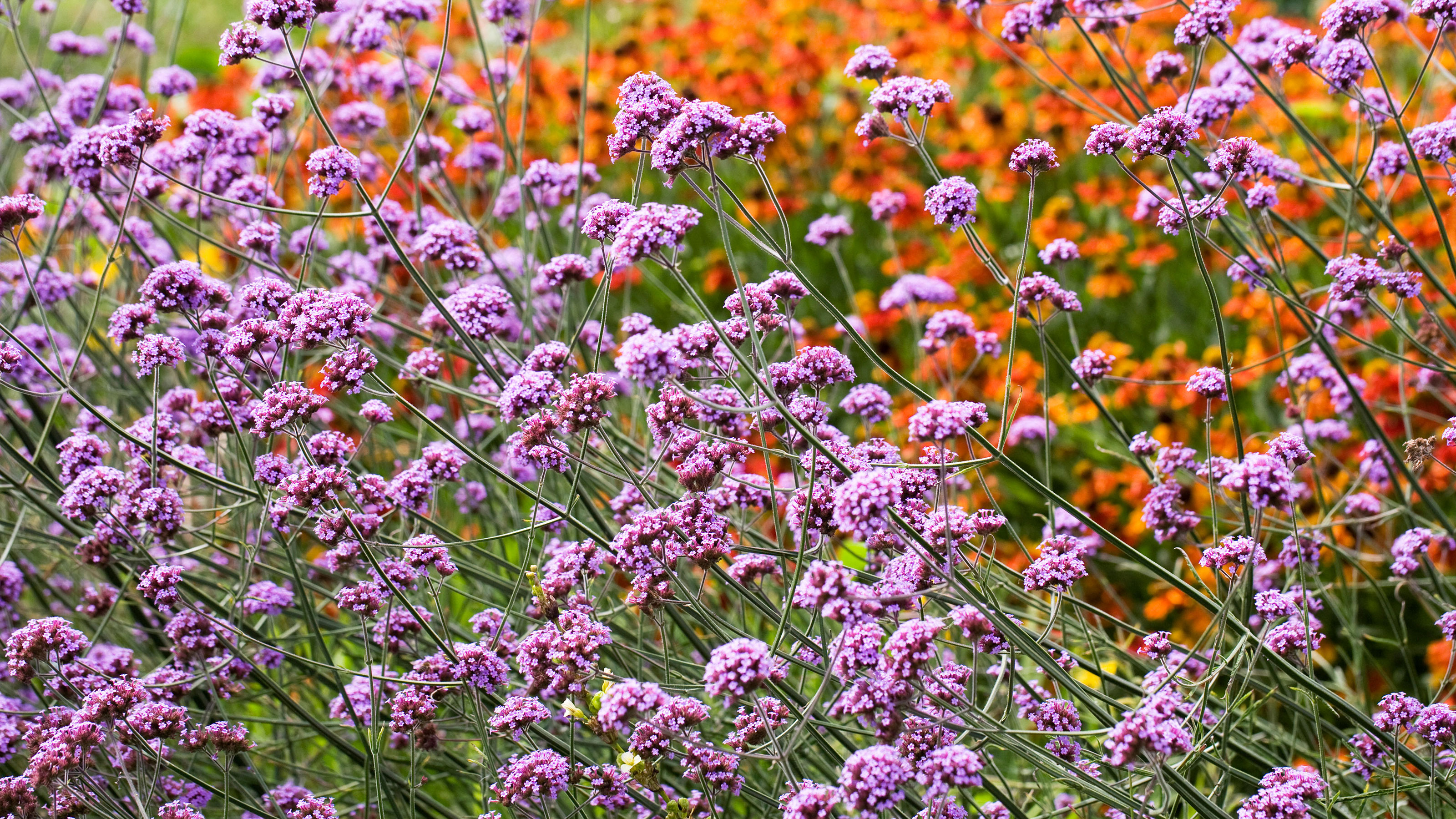

To forgo purple flowers in your garden is to miss out on the many glorious shades within its spectrum. Marrying red and blue, purple encompasses velvety damson and fiery magenta, through to midnight indigo. All of these create impact in the border; while pastel purples offer softness.
The late Christopher Lloyd, who is known for his clever use of color at Great Dixter in East Sussex in the UK, loved magenta (which he defined as ‘purple with a strong dash of red admixed’). ‘It is quite a startling color and therefore has many enemies,’ he wrote in his book Color for Adventurous Gardeners. Ignoring the color-phobes, he planted it with abandon: ‘Don’t feel you have to be subtle in your use of magenta,’ he encouraged.
However, when it came to darker purples, he was wary: ‘An all-purple border, unless relieved with touches of some other color, is a mistake, especially in Britain, when we so often cower beneath grey skies.’ Contrast is vital, he said. Buddleja davidii ‘Black Knight’, for instance, is fabulous beside fiery orange or rich mauve.
Mauve was another of Lloyd’s favorite purple hues, and he often planted it beside yellow in his flower bed ideas: for example, Verbena bonariensis with Patrinia scabiosifolia, and Campanula lactiflora 'Prichard's Variety’ with Stipa gigantea. But personal taste is paramount, so it’s best to opt for colors you love. The Queen, for instance, is seemingly not a fan of mauve, having banned it from palace flower arrangements.
Whatever your favorite shade of purple flowers, plant them and enjoy the joyous sight of stunning blooms come summer.
16 purple flowers to add vibrant color
Whether you opt for dark-crimson tones or a more subtle lavender hue, these purple flowers are guaranteed to turn heads. Find your favorites in our beautiful selection.
1. Cynara cardunculus AGM
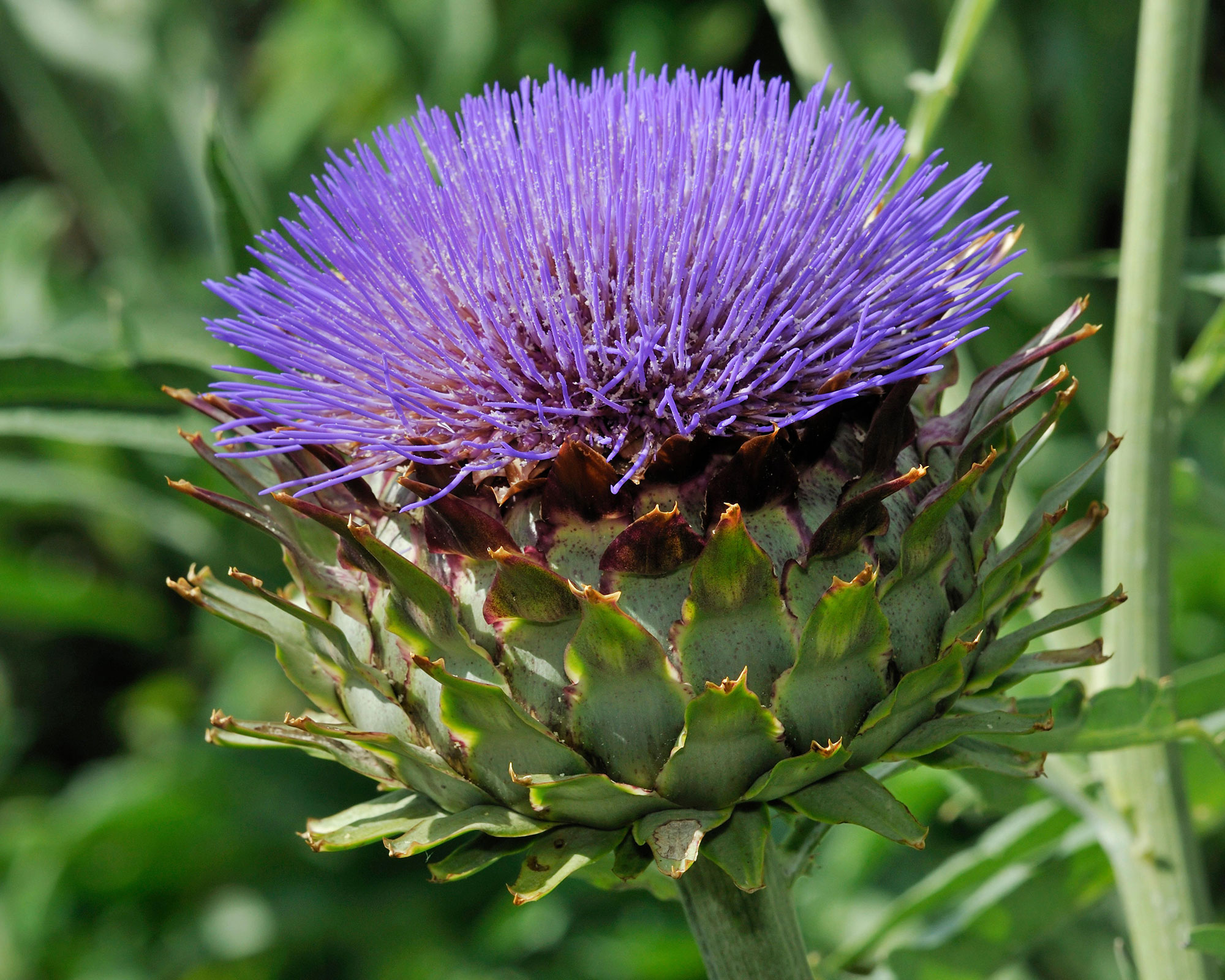
- Hardiness: USDA 7-9 (UK H5)
- Height: 5-8ft (1.5-2.5m)
Architectural cardoon creates a mass of silver foliage topped with thistle-like purple flowerheads, from early summer to early fall. The seedheads can be dried for the house or left to provide interest in garden borders during fall and winter.
It will grow best in well-drained soil in sheltered sun. A good planting partner is Helianthus annuus ‘Claret' AGM.
2. Verbena bonariensis AGM
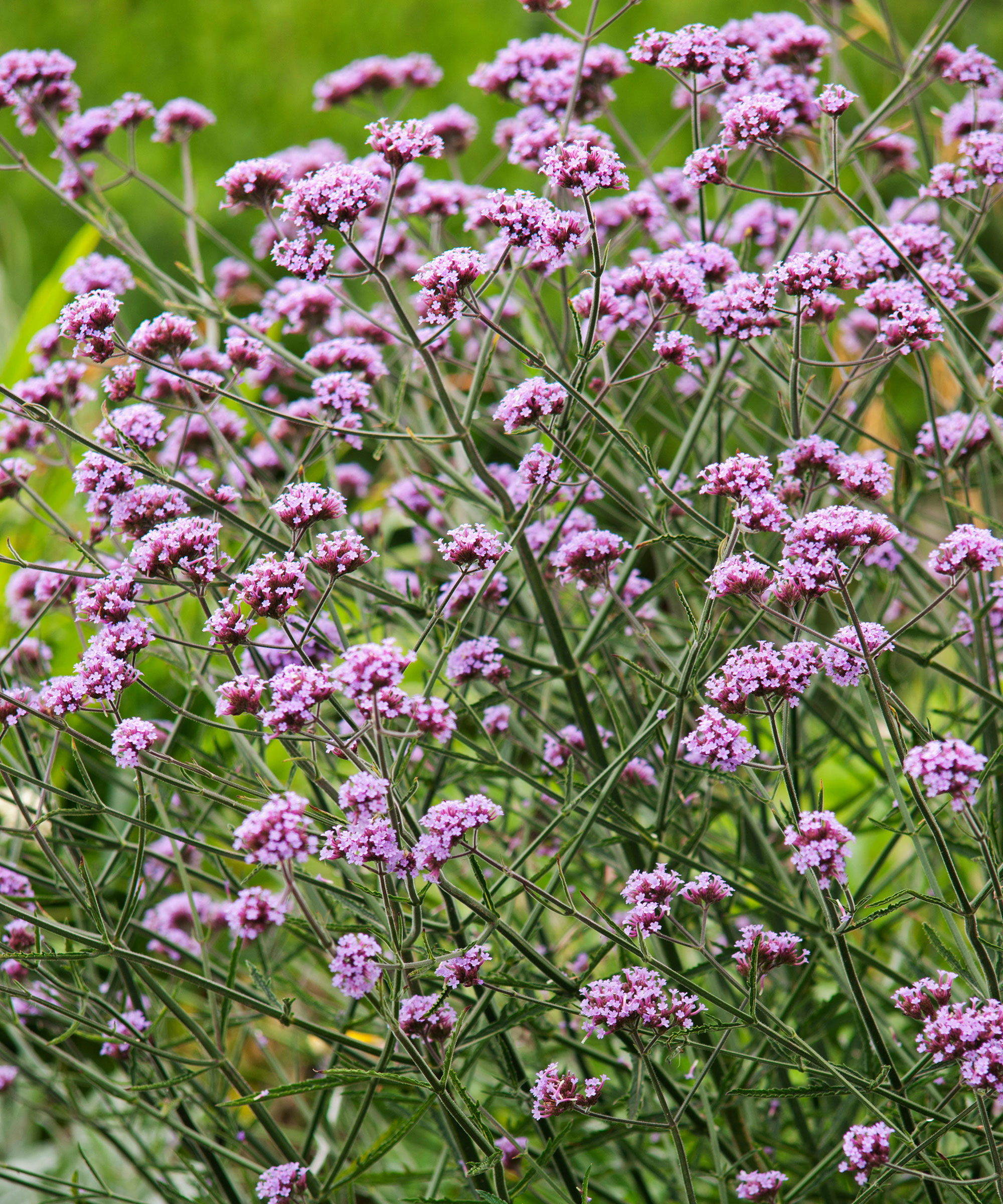
- Hardiness: USDA 7-11 (UK H4)
- Height: 6ft (1.8m)
This short-lived perennial is often grown as an annual, in well-drained soil in sun. Sow from seed or buy as a bedding plant.
The purple top has small clusters of purple flowers on slender stems in summer and fall. Having a ‘see-through’ quality, it can be grown in the middle of the border. A good planting partner is Helianthus ‘Lemon Queen’ AGM with its pale yellow flowers.
Do make sure you wear long-sleeves and gardening gloves to handle vervain, however, as it can irritate skin.
3. Campanula portenschlagiana AGM
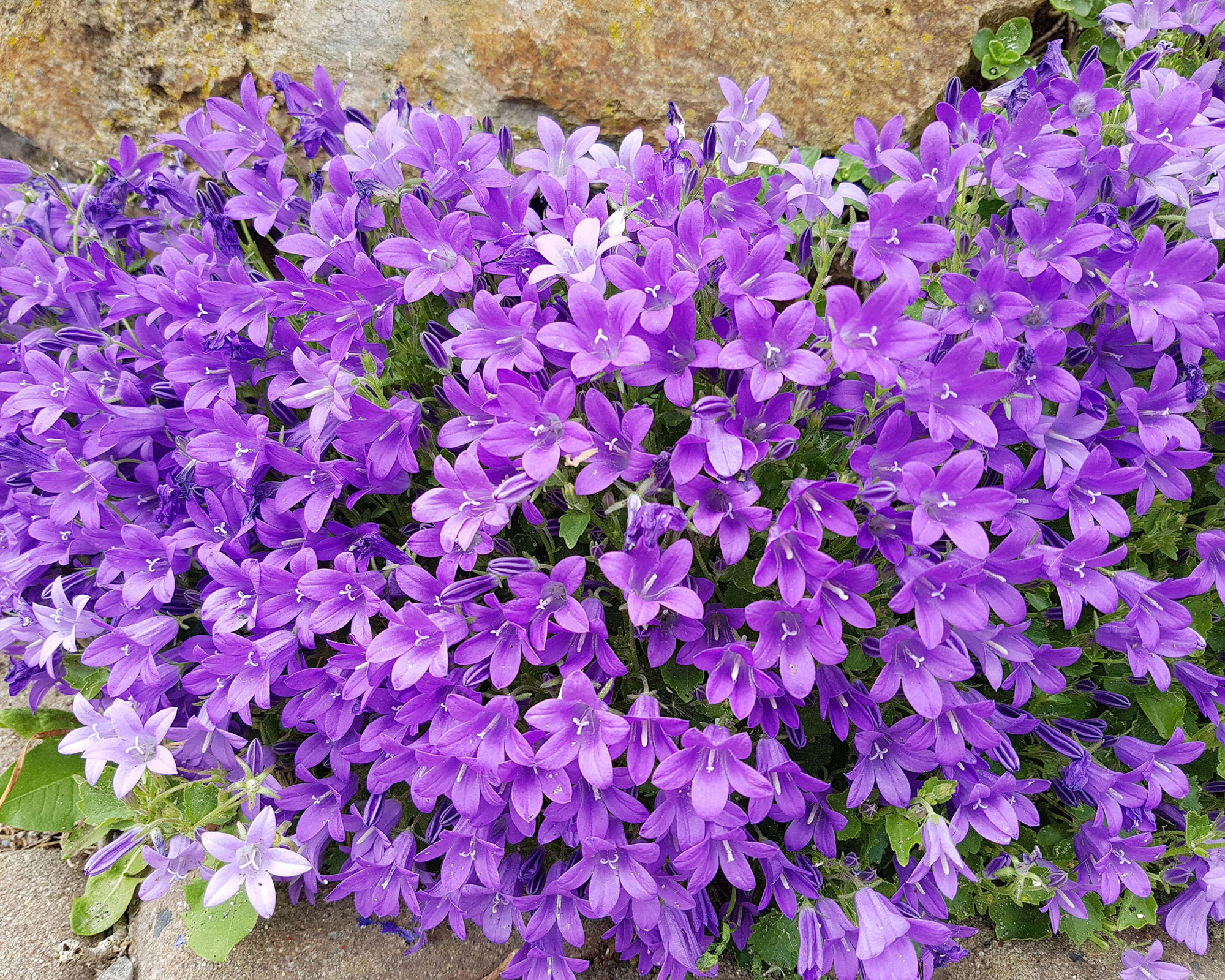
- Hardiness: USDA 4-8 (UK H5)
- Height: 8in (20cm)
Beautiful flowering at the border edge or tumbling down garden walls, this mat-forming evergreen perennial produces sunset-violet bells in summer.
The wall bellflower likes well-drained soil in sun or semi-shade; soil must be moist in full sun. As one of the best plants for garden walls, you can introduce it into cracks in walls or even paving and it will spread vigorously in the right conditions.
4. Salvia nemorosa ‘Caradonna’ AGM
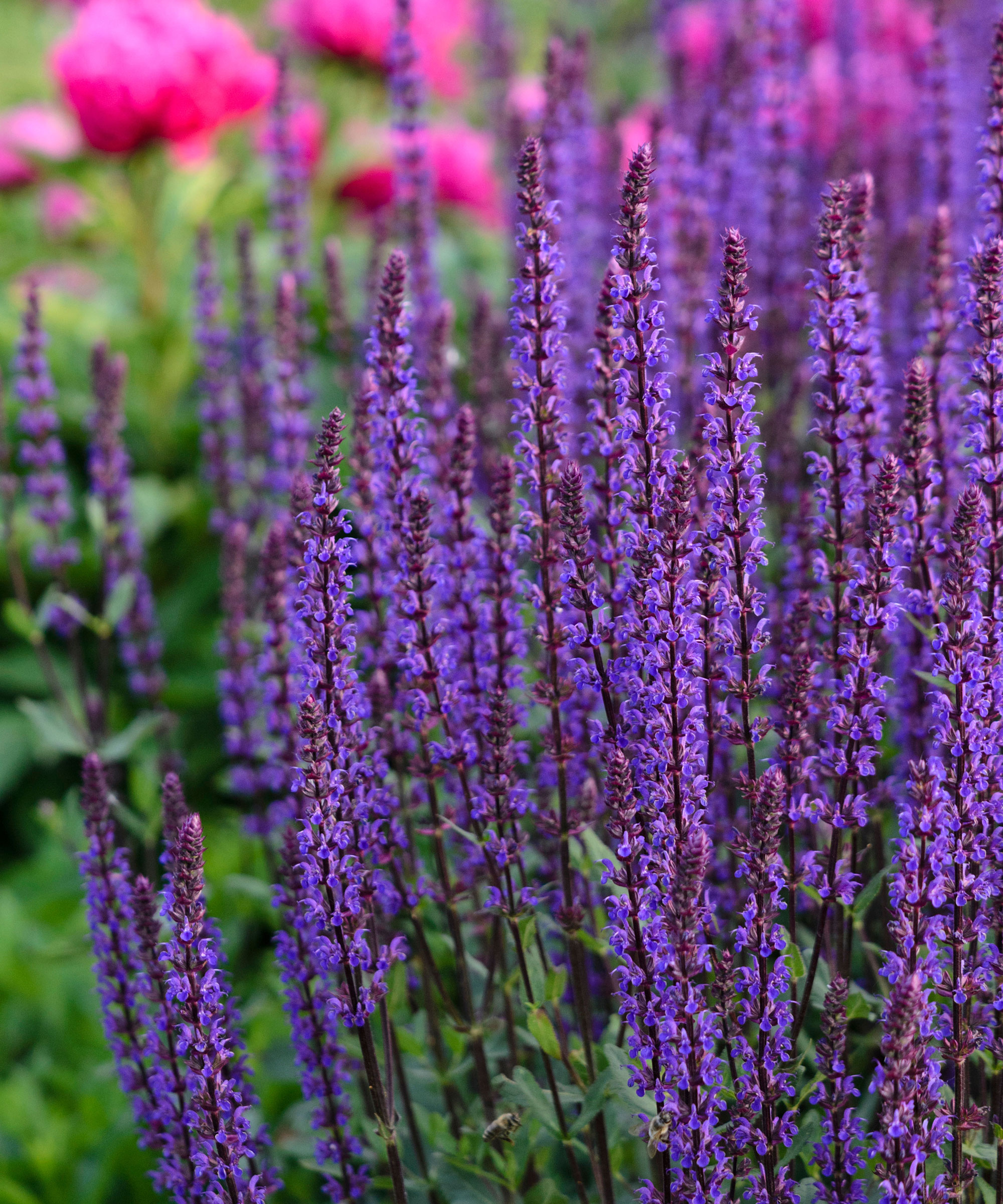
- Hardiness: USDA 4-8 (UK H7)
- Height: 20in (50cm)
Rich-purple flowers on almost-black stems create patches of upright color. Bees love this smart Balkan sage, which blooms during summer and early fall.
Plant this perennial in well-drained soil in sun. Protect the young spring growth from slugs, and make sure you cut it back after flowering to encourage a second flush of bloom. A good planting partner is Achillea millefolium 'Cerise Queen'.
5. Iris ‘Dusky Challenger’
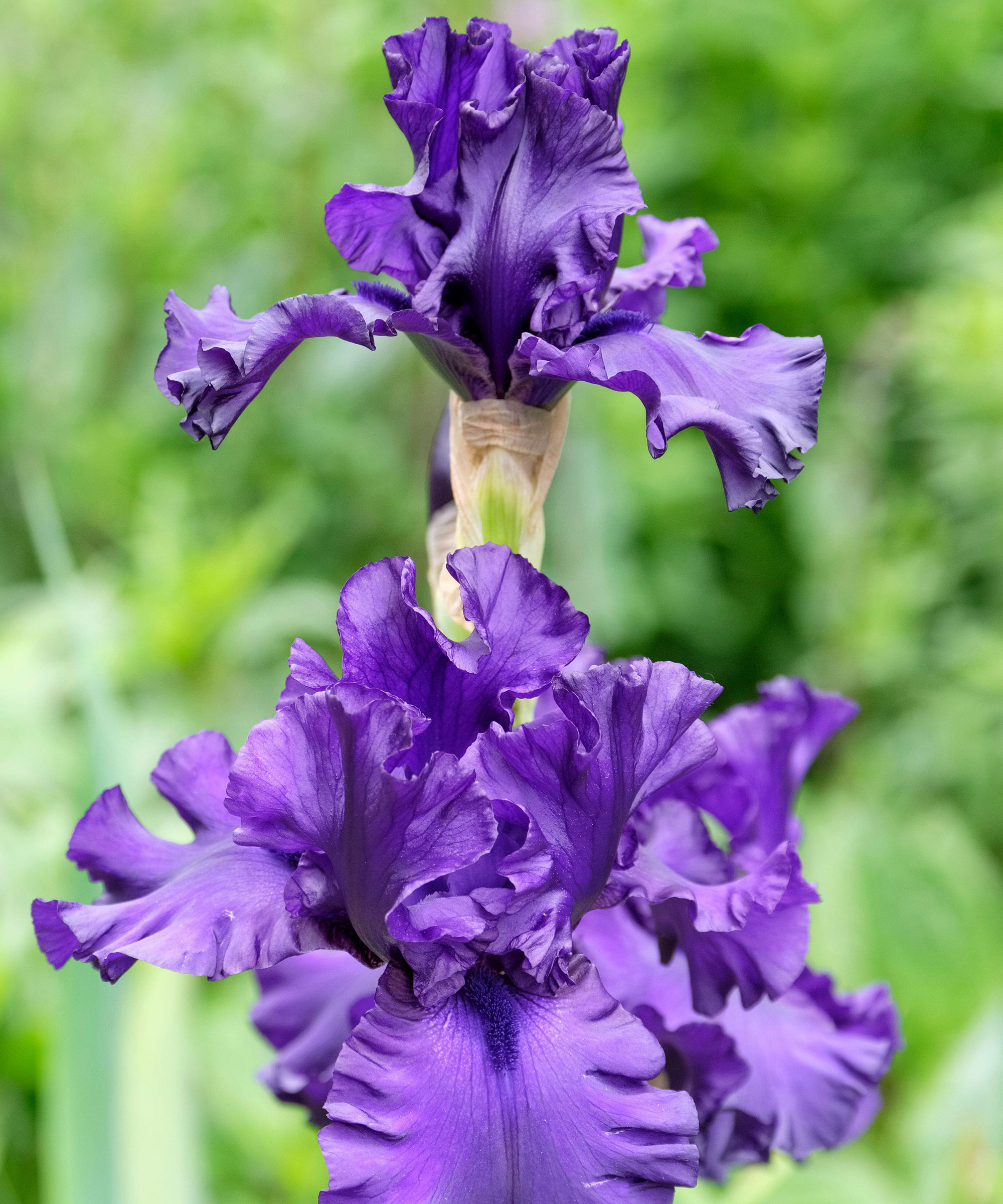
- Hardiness: USDA 5-9 (UK H7)
- Height: 38in (95cm)
This regal bearded iris commands attention when it blooms in late spring and early summer. The dark-purple ruffled flowers have a satin sheen and emerge from black buds.
Plant shallow in well-drained sun-baked soil and allow elbow room because bearded irises like sun on their rhizomes. Lift and divide every 2-4 years to ensure they continue to grow well. Combine with the soft pink and violet blooms of Iris ‘Florentine Silk’ for a stunning garden color scheme.
6. Ipomoea tricolour ‘Grandpa Ott’
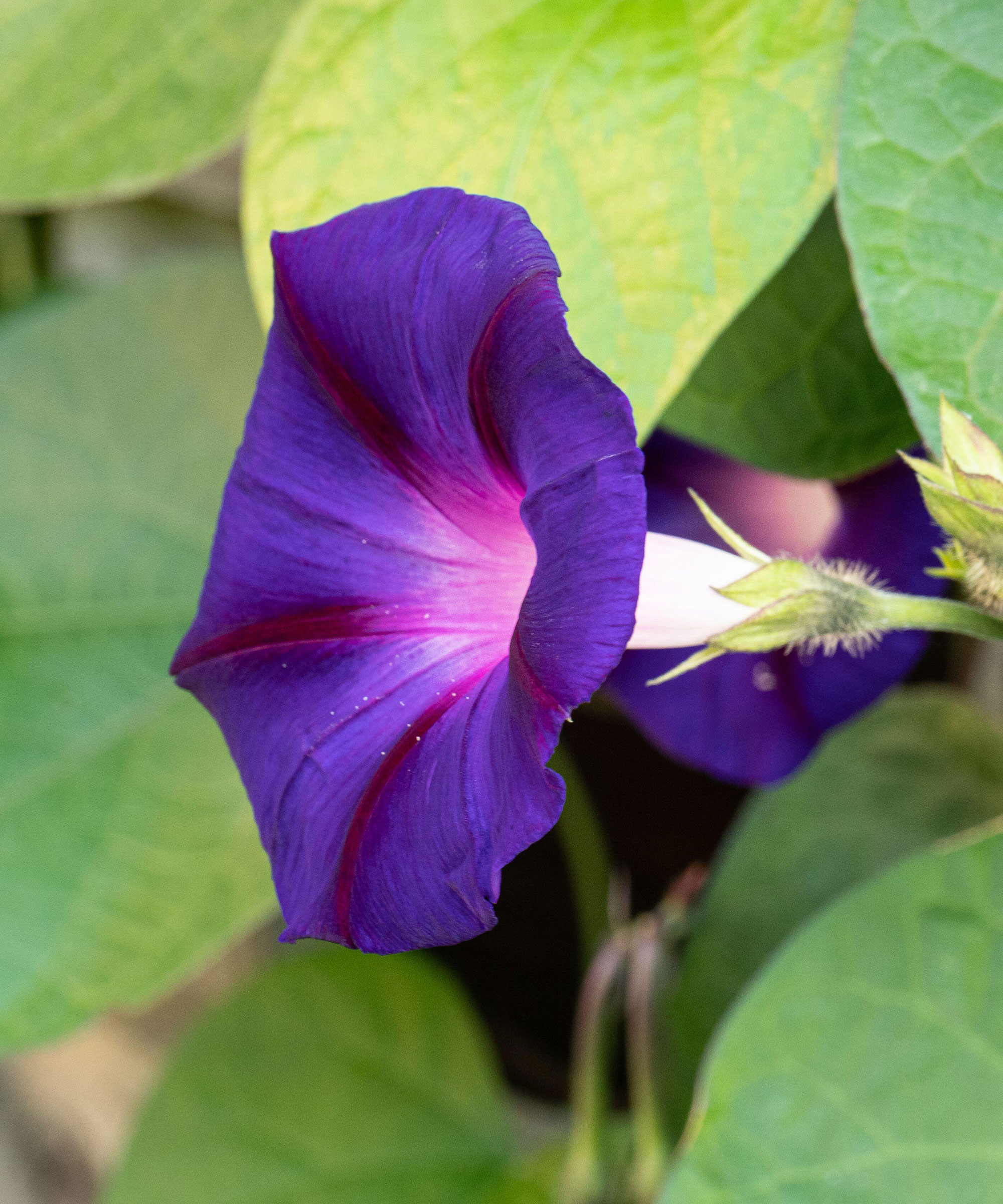
- Hardiness: USDA 2-11 (UK H1C)
- Height: 6-10ft (2-3m)
The large trumpet flowers of this morning glory are inky-purple marked with red stars. This short-lived perennial climber is grown as an annual in cold climates.
Sow under cover (a windowsill or greenhouse) in early spring or sow direct in late spring, in retentive, well-drained soil in sun. Don’t grow in US regions where it is considered an invasive plant, such as Arizona.
7. Aster x frikartii ‘Mönch’ AGM
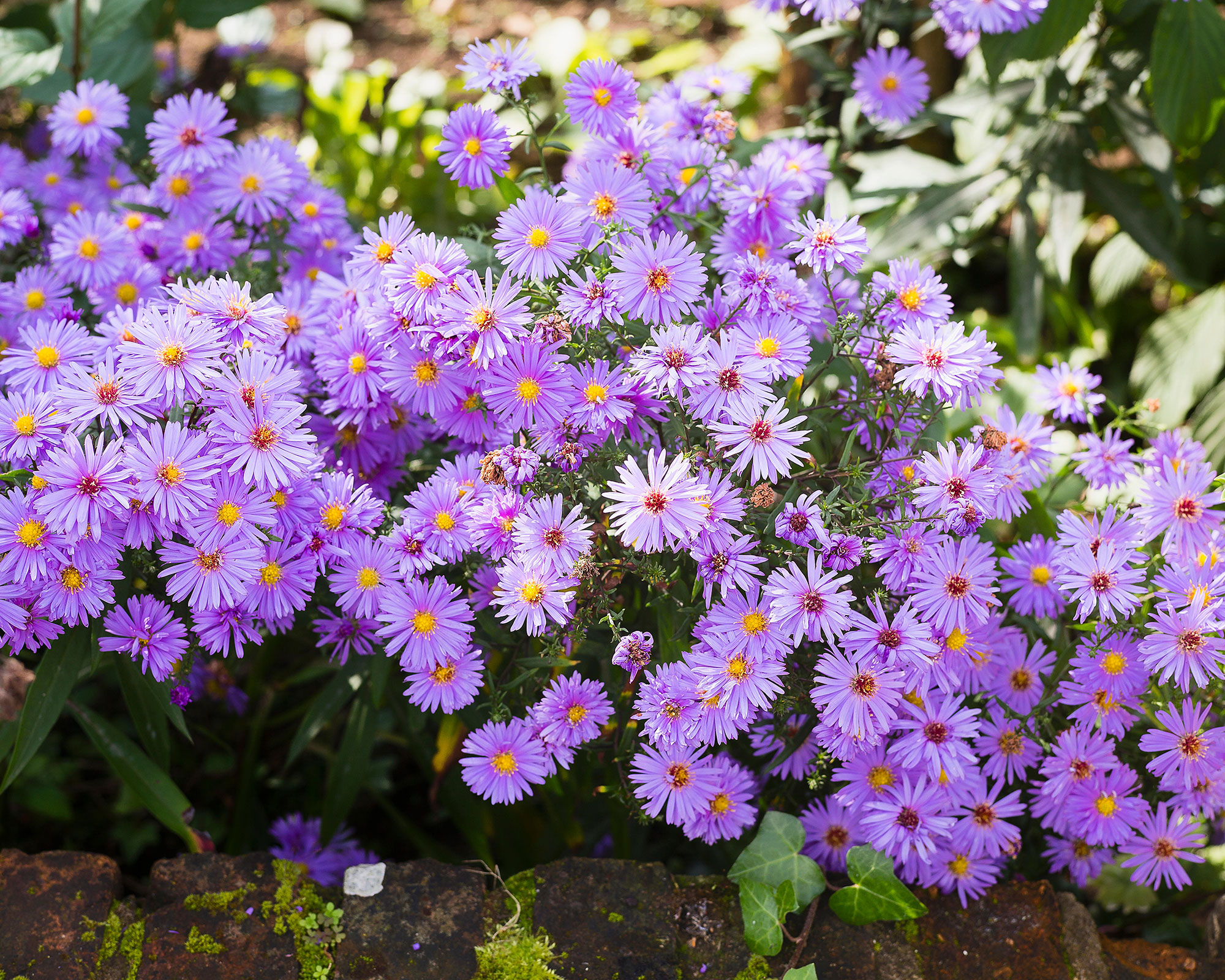
- Hardiness: USDA 5-10 (UK H7)
- Height: 2-3ft (60-90cm)
Asters are a joy in late summer and early fall, and this variety produces generous clumps of blue-purple daisies with golden bosses, which feed bees before winter sets in.
Grow this mildew-resistant perennial in well-drained humus-rich soil in full sun, in an open site. It looks great with blonde grasses and border stonecrops (Hylotelephium), or team with other types of asters for an added burst of seasonal color.
8. Veronicastrum virginicum ‘Fascination’
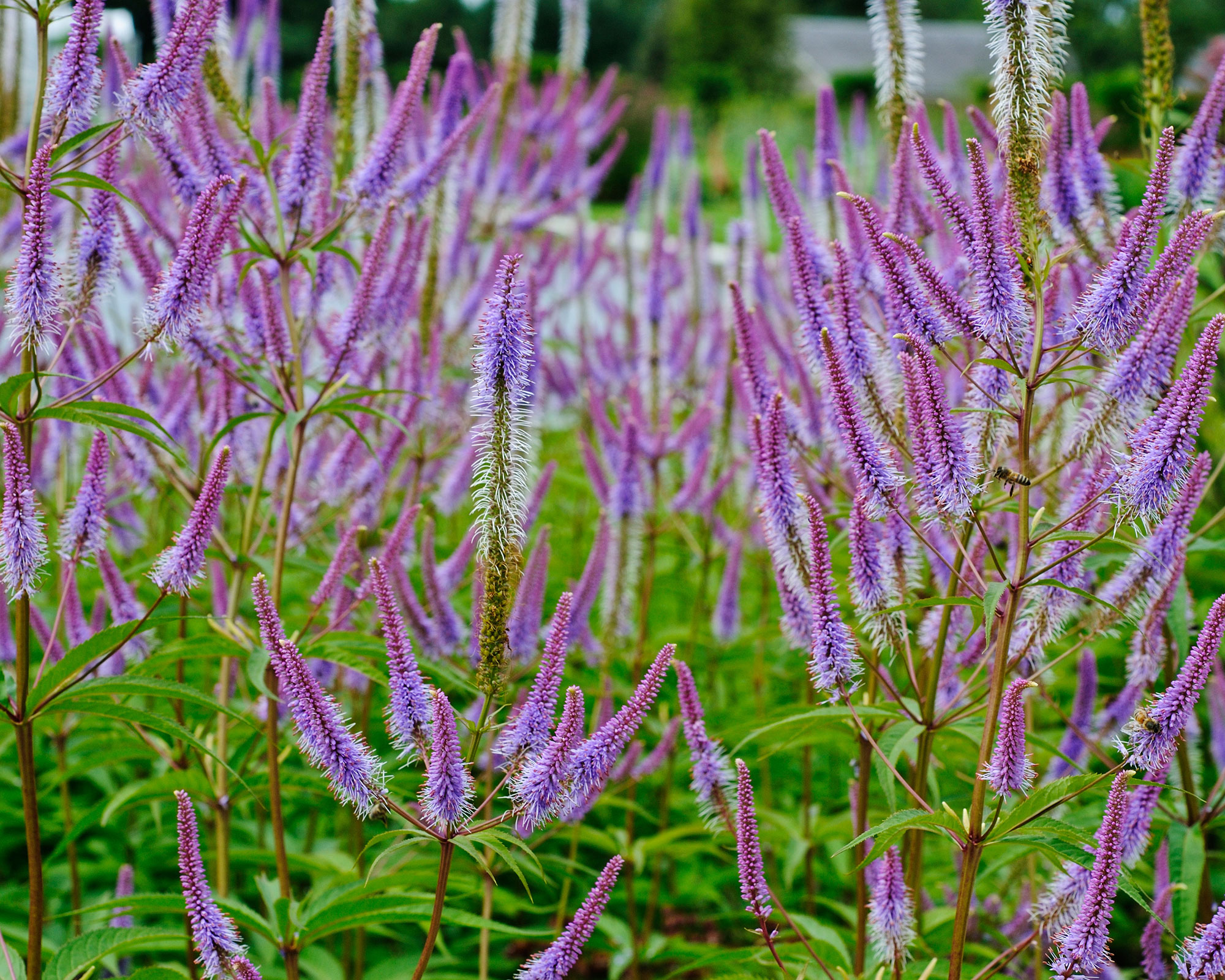
- Hardiness: USDA 3-8 (UK H7)
- Height: 4ft (1.2m)
Gorgeous candelabras of pastel-purple flower wands that are visited by bumblebees from mid summer to early fall, tower above whorls of long, pointed green leaves.
Plant this Culver’s root in moist, humus-rich, fertile, well-drained soil in sun or semi-shade. Do make sure you protect young plants from rabbits in countryside gardens, as they will happily eat their way through them.
A good planting partner to complement these purple flowers is Persicaria amplexicaulis 'Firetail' with its crimson red blooms.
9. Lavandula x intermedia ‘Grosso’
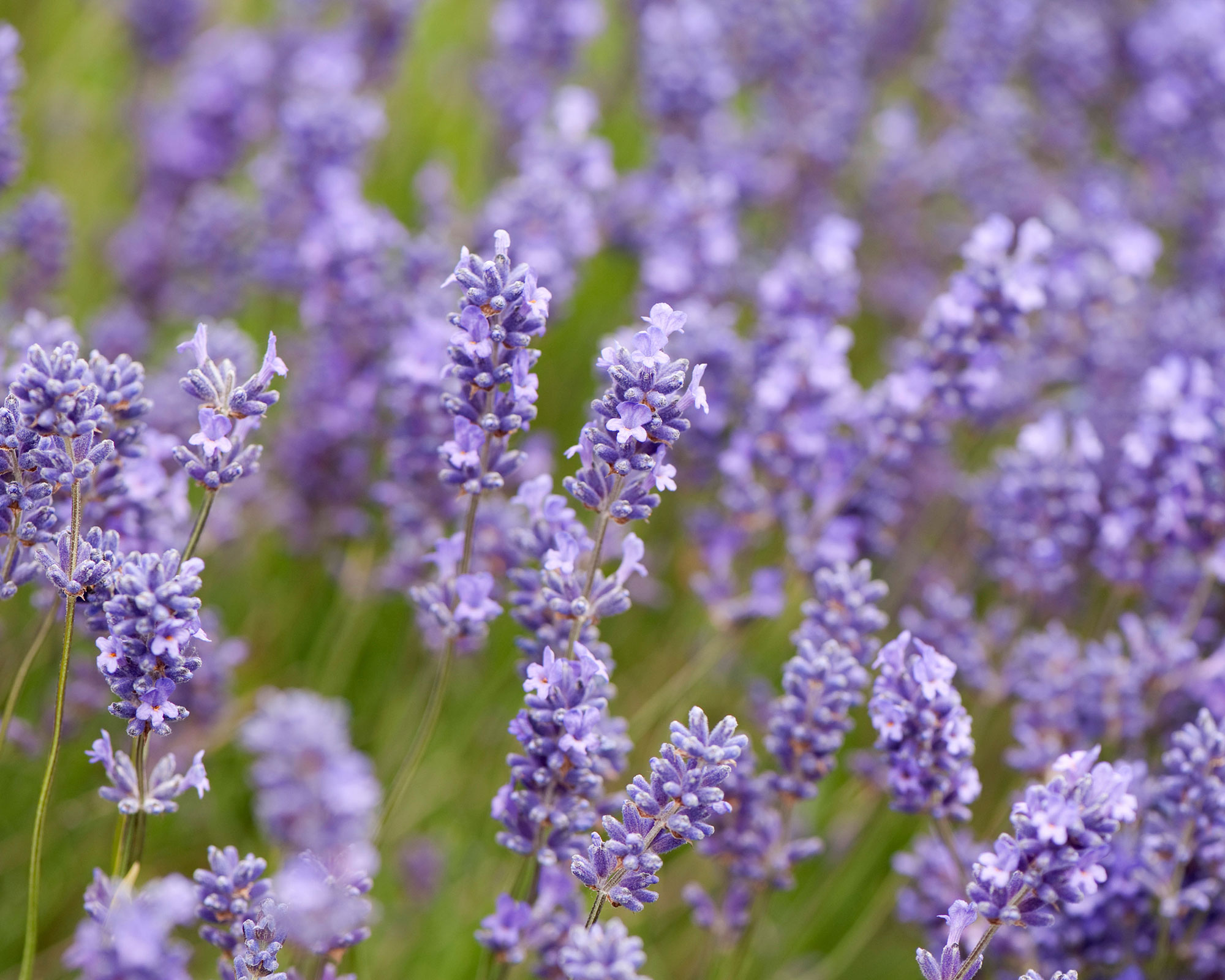
- Hardiness: USDA 5-8 (UK H5)
- Height: 3ft (90cm)
An abundance of soft blue purple flowers and aromatic leaves make this a winner. What's more, studies show that bees prefer the tall, hardy intermedia lavenders, which are farmed for oil, so be sure to add this bee friendly plant to your planting scheme
Best in very well-drained soil in full sun. Grown into low hedging as a garden edging idea for pathways allows legs to release scent every time they brush the aromatic evergrey leaves.
Team with the low-growing, pink flowered blooms of Cistus × pulverulentus ‘Sunset' AGM.
10. Papaver somniferum ‘Lauren’s Grape’
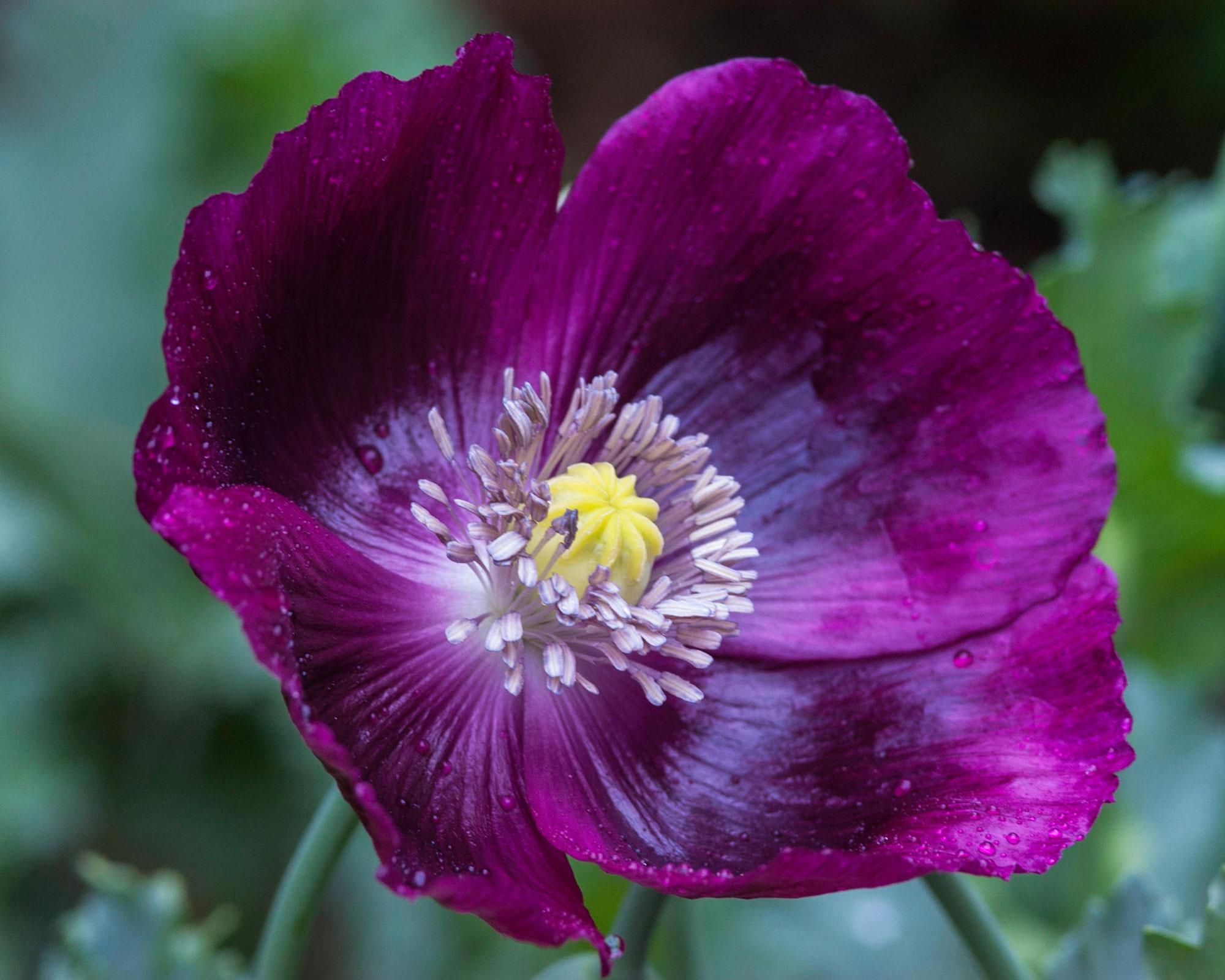
- Hardiness: USDA 4-10 (UK H5)
- Height: 3ft (90cm)
The cupped petals of this opium poppy are decadent plum-purple and claret, above silver-blue foliage. Can be grown as part of a mini annual ‘meadow’.
Sow this hardy annual direct in spring for summer flowers. Opium poppies love very well-drained soil in full sun. They will self-seed with gusto, if you don’t deadhead after flowering.
11. Angelica gigas
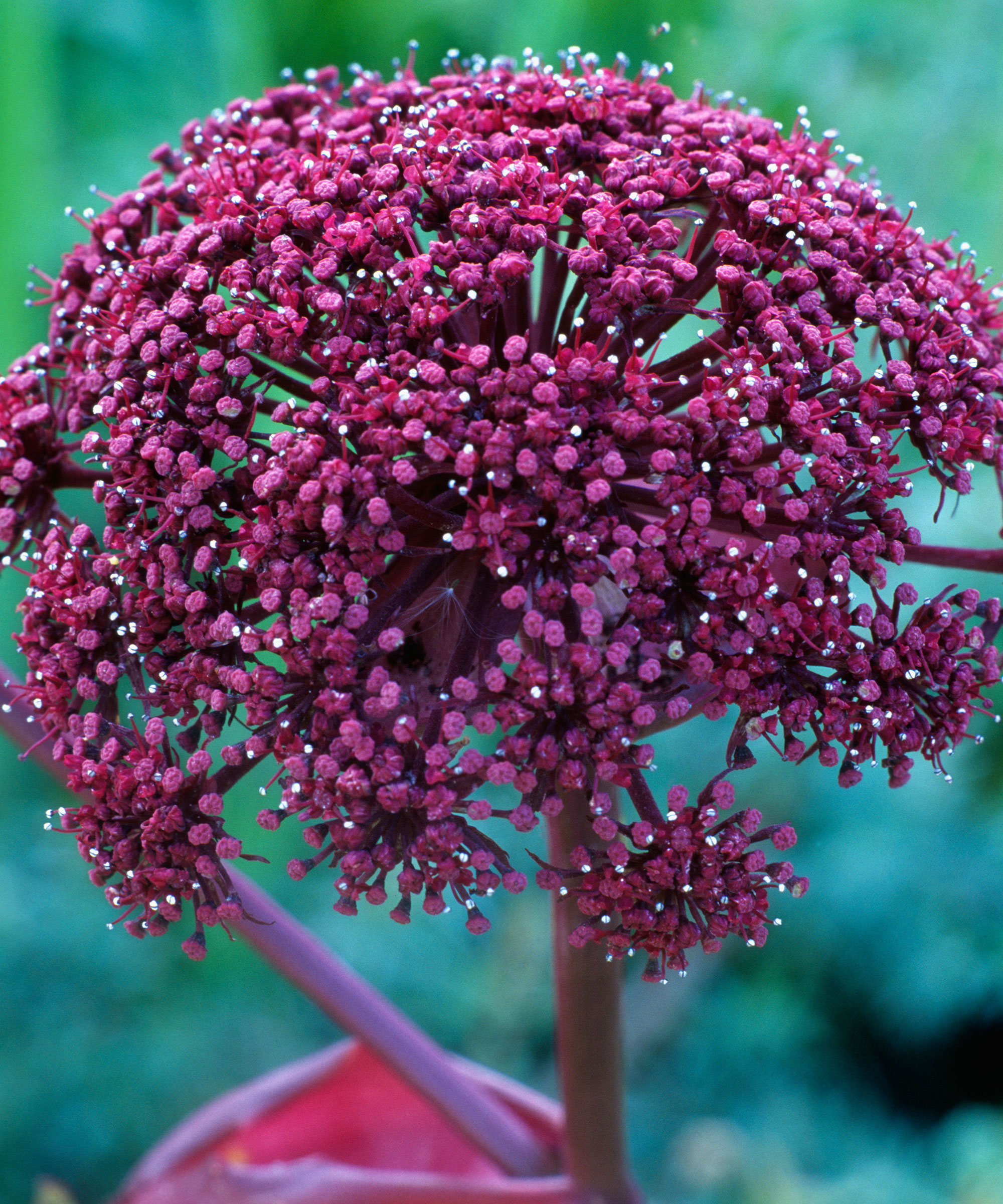
- Hardiness: USDA 5-7 (UK H6)
- Height: 4-6ft (1.2-1.8m)
This glorious, architectural angelica is a biennial or short-lived perennial that produces red-purple domed umbels atop thick wine stems in late summer and early fall.
Grow in deep, moist soil in semi-shade. It attracts a lot of insects, so don’t plant it near a patio or a path – it is best at the back of the border. Follow our tips on how to get rid of slugs to protect the young leaves from these common garden pests.
12. Cerinthe major ‘Purpurascens’
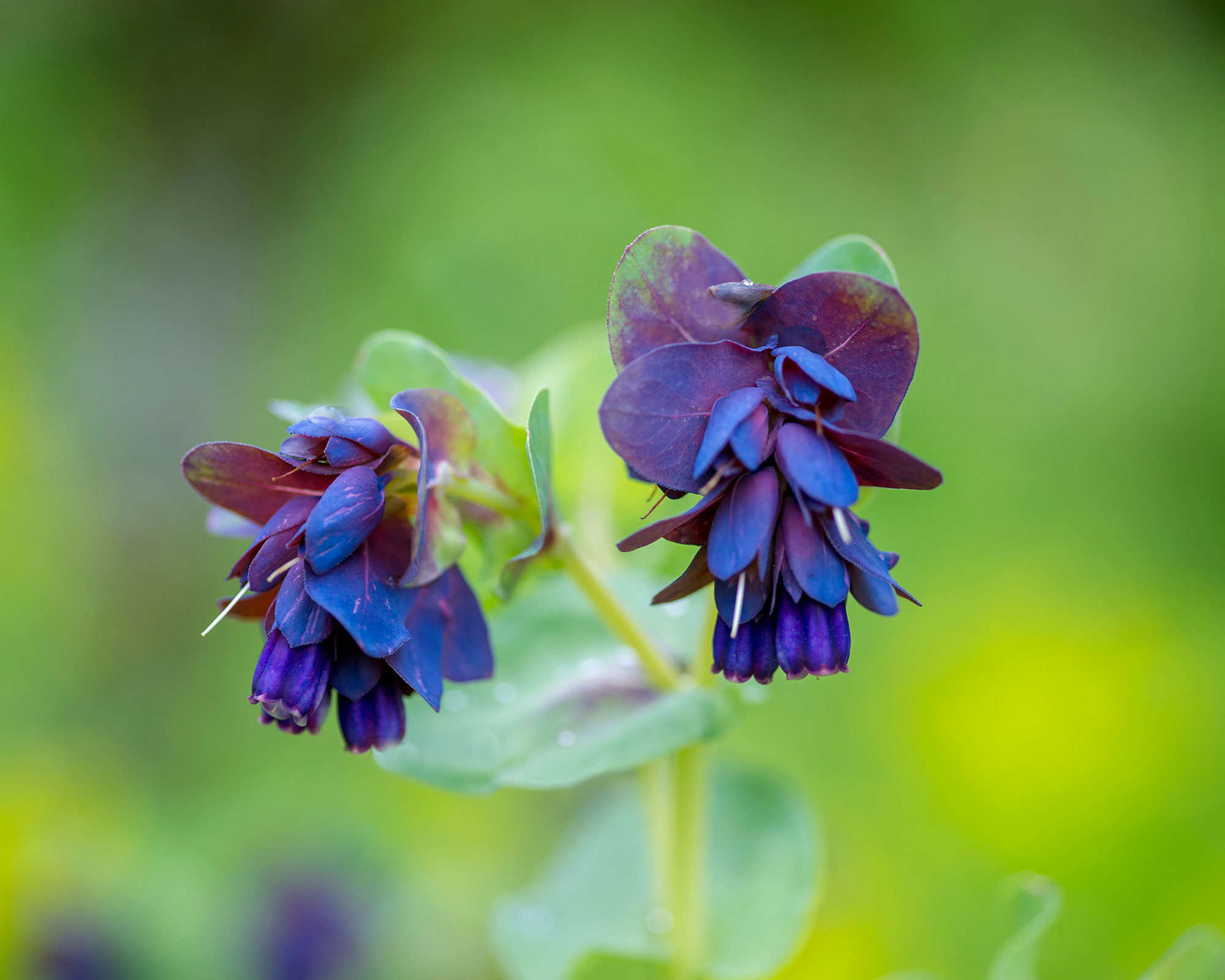
- Hardiness: USDA 8-10 (UK H3)
- Height: 2ft (60cm)
This honeywort has black-purple tubular flowers amongst blue-purple bracts. The bees love it and it’s also a good choice if you're searching for the best cutting garden flowers. In the right conditions, it will self-sow.
Sow this hardy annual under cover in early spring or sow direct in late spring or early summer, in well-drained, fertile soil in sheltered sun. Soak the seeds overnight before sowing.
Team with the orange flowers of Eschscholzia californica, also known as The California Poppy.
13. Lobelia x speciosa ‘Hadspen Purple’
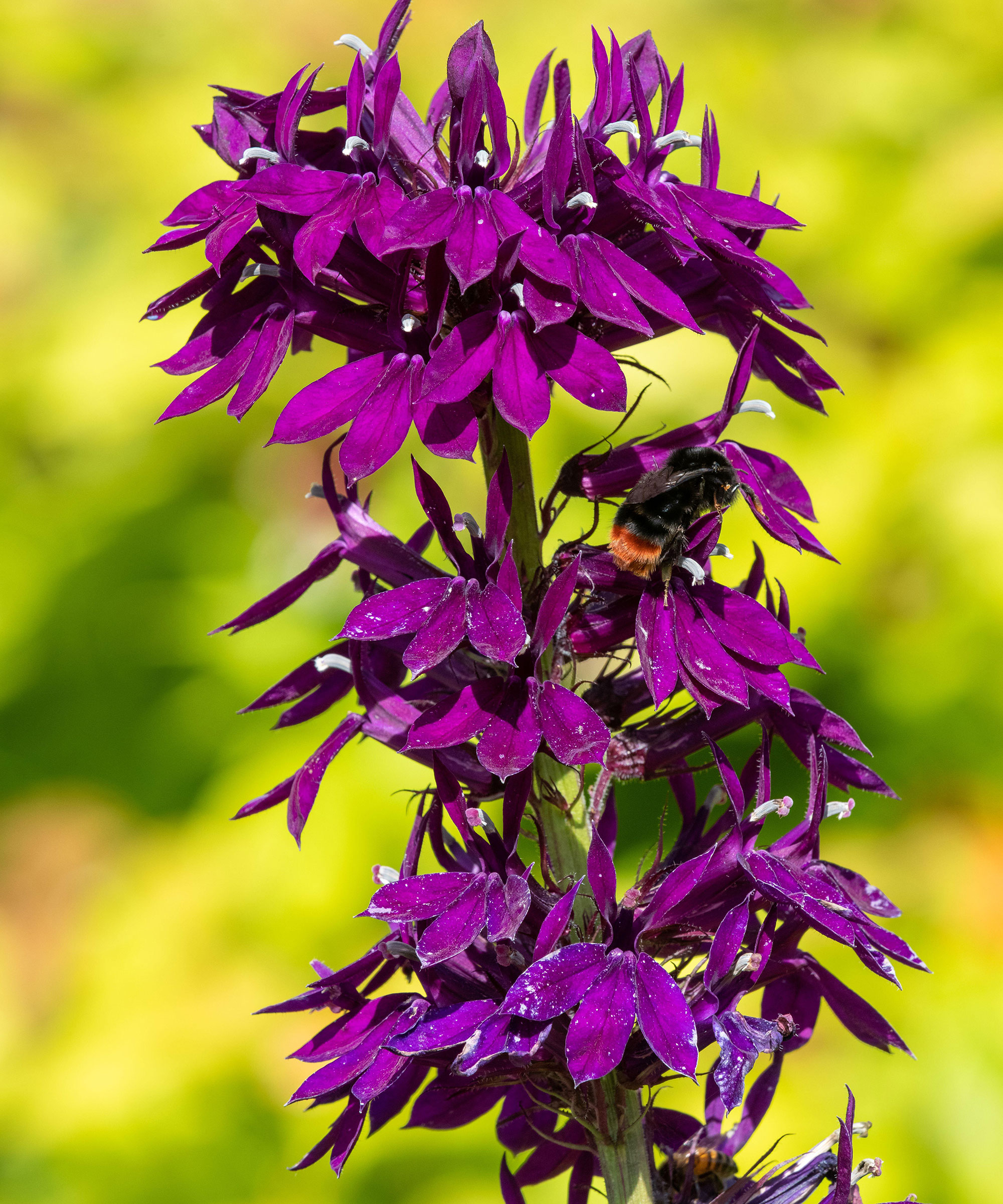
- Hardiness: USDA 5-8 (UK H5)
- Height: 2ft (60cm)
This short-lived perennial has spires of Tyrian-purple flowers that add warm, rich color and vertical accents to moist borders from mid summer to early fall.
Happy in the damp, well-drained, fertile soil of a bog garden. Protect from slugs and provide support in exposed sites. Cover the crown with a thick, dry mulch before winter.
You can find more of the top moisture-loving bog plants in our dedicated guide.
14. Rosa ‘Veilchenblau’ AGM
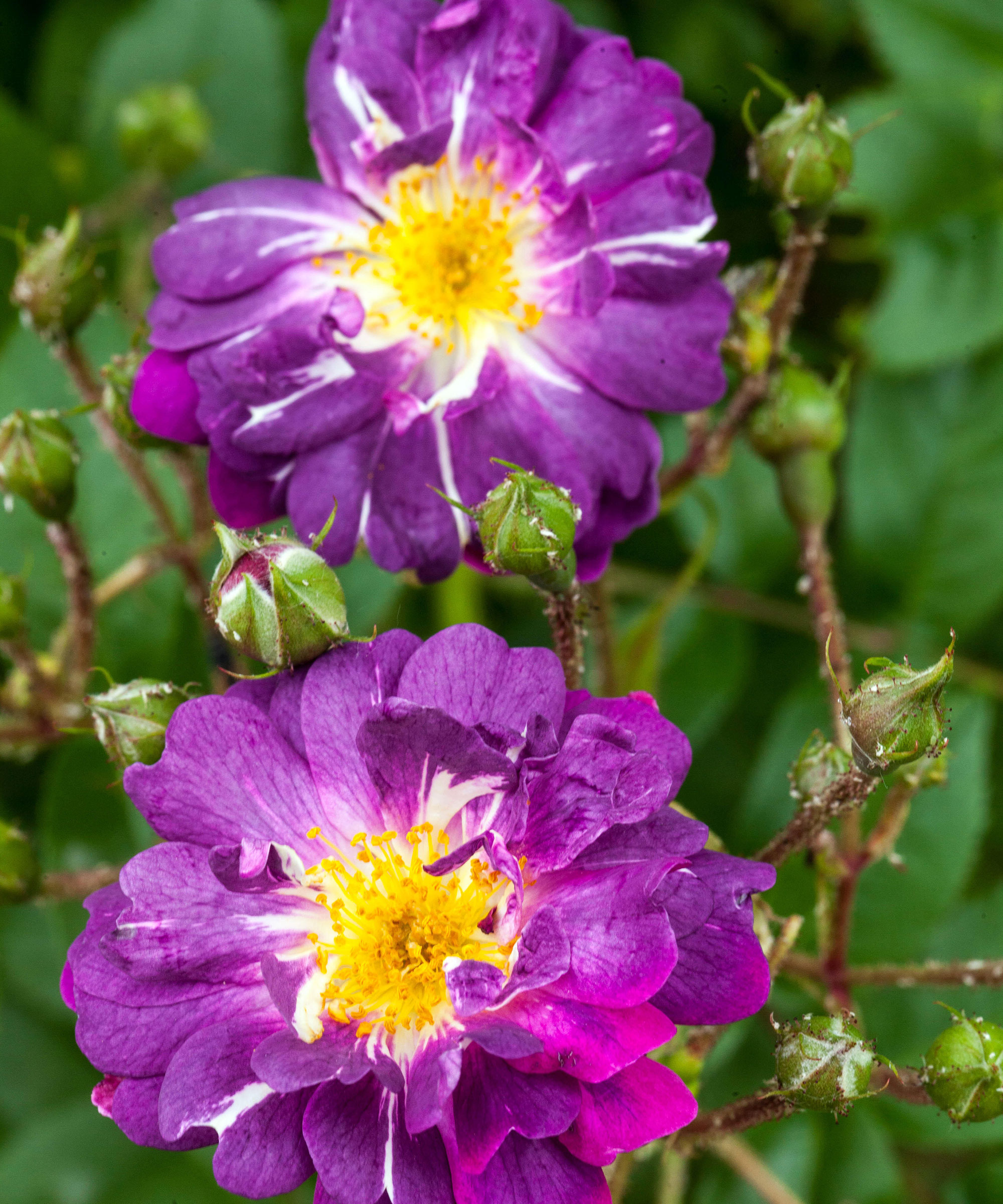
- Hardiness: USDA 5-9 (UK H7)
- Height: 15ft (4.5m)
This old, healthy rambling rose has violet-magenta blooms with a white center and golden stamens that attract bees and hoverflies and eventually fade to grey-lilac.
Being almost thornless, this is a great type of rose to grow over an archway or porch. It is tolerant of semi-shade and poor soil, but – like all roses – prefers rich, fertile soil in full sun.
Offset the purple flowers with another almost thornless rambling rose, Rosa 'Ghislaine de Féligonde', with its beautiful apricot-colored blooms.
15. Symphyotrichum novae-angliae 'Helen Picton’ AGM
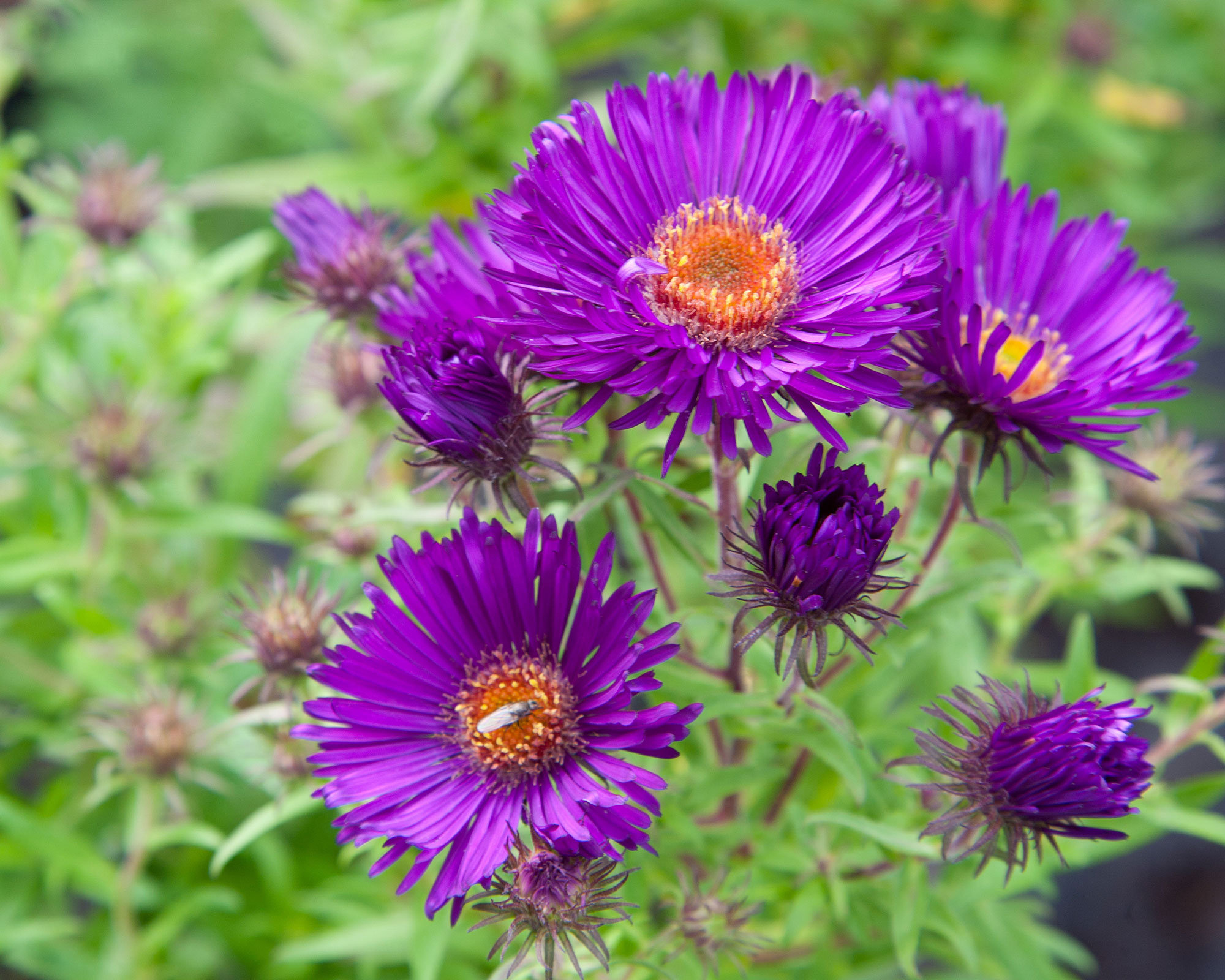
- Hardiness: USDA 5-8 (UK H7)
- Height: 4ft (1.2m)
Bees visit the rich magenta-purple daisies of this New England aster in late summer and early fall.
Plant this mildew-resistant variety in retentive, well-drained, neutral to alkaline soil in open sun. Having an upright habit, it rarely needs staking. Lift and divide every 3-5 years. A good planting partner is Sanguisorba tenuifolia var. alba.
16. Verbascum phoeniceum ‘Violetta’
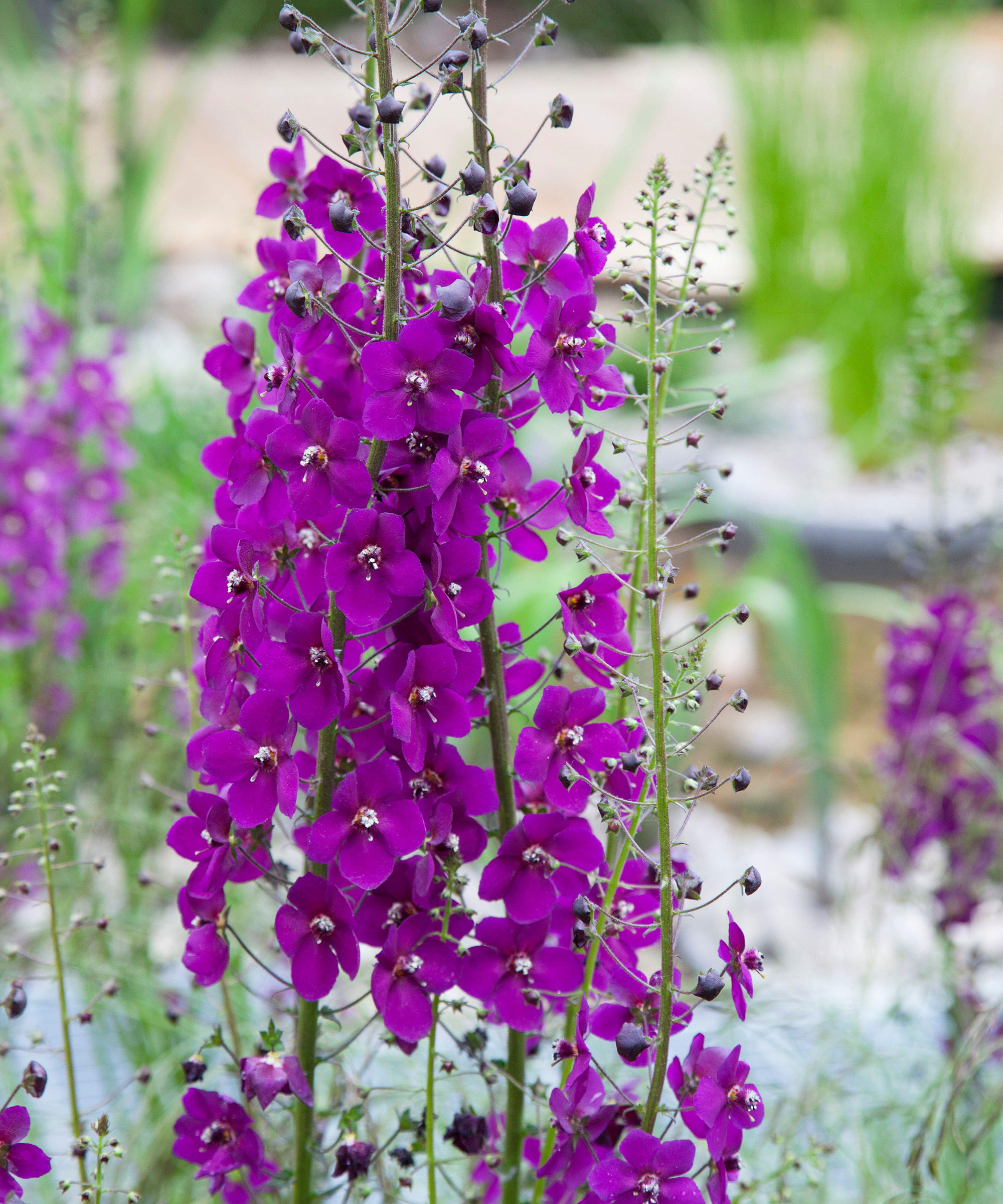
- Hardiness: USDA 5-8 (UK H6)
- Height: 31in (80cm)
This short-lived perennial produces wands of magenta-purple flowers above rosettes of wrinkled, veined green leaves, from early to late summer.
Plant this mullein in well-drained neutral to alkaline soil types in full sun. Cut spent flower spikes back to encourage re-flowering. Can be grown from seed and may self-seed.
The orange blooms of Geum ‘Totally Tangerine’ are ideal as a planting partner.
Which purple flowers attract wildlife?
Butterflies love the deciduous shrub Buddleja davidii ‘Black Knight’, which has panicles of bold-purple flowers in late summer; the short-lived perennial Verbena hastata, which has airy candelabras of purple blooms atop very thin stems that allow plants behind to be glimpsed; and the bedding plant heliotrope, which has dense purple flowerheads that smell of cherry pie.
Bees adore the evergreen aromatic shrub Lavandula x intermedia ‘Sussex’, which fills the air with reviving scent; the perennial Salvia ‘Amistad’, which has exotic-looking rich-purple flowers; and the woolly blue-purple bloom of Salvia ‘Blue Spire’ (Perovskia ‘Blue Spire’) – a sub-shrub that has ghostly silver stems in winter. Do not grow Acanthus mollis, as bees can get stuck in it.
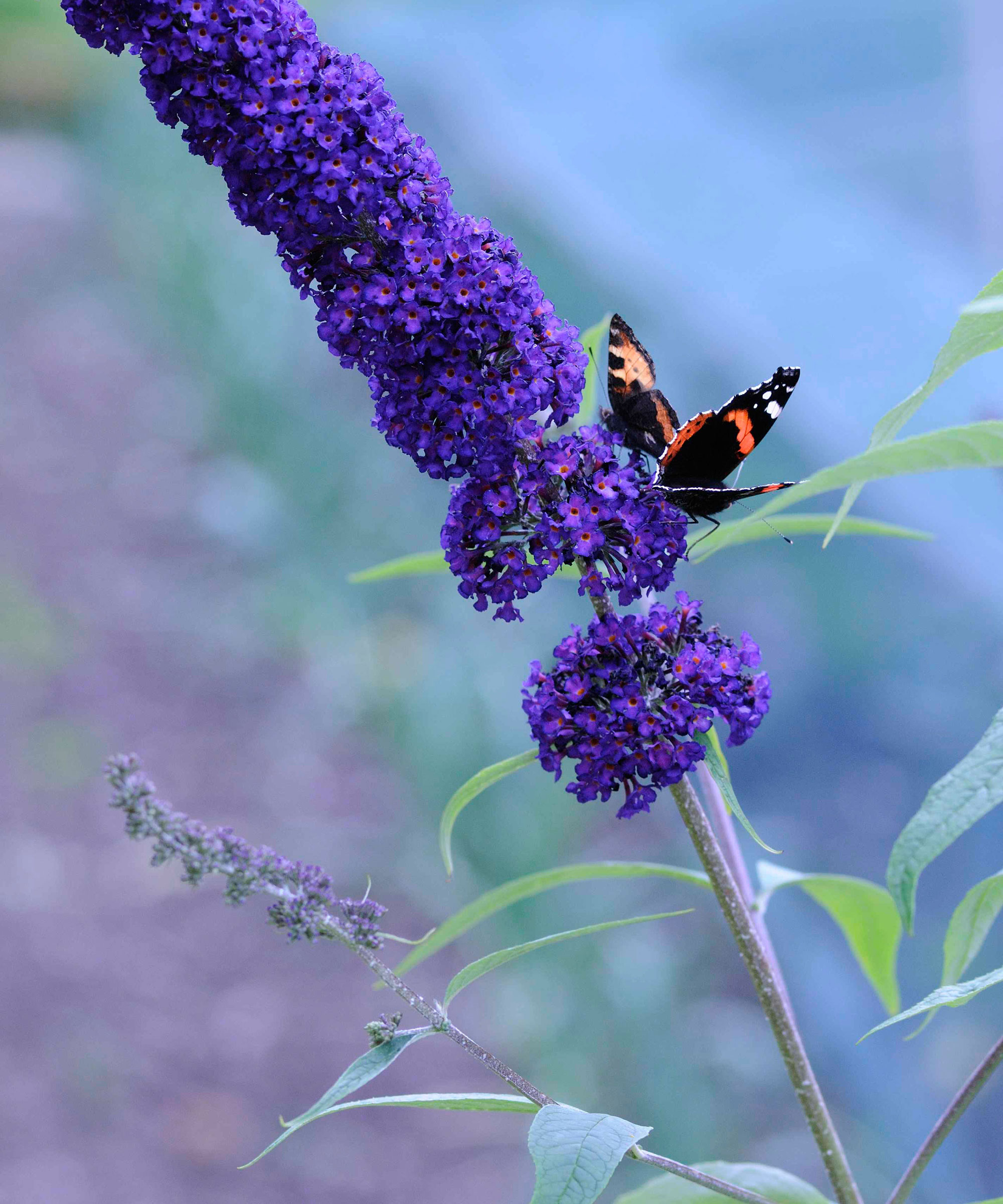
Buddleja davidii 'Black Knight' attracts all kinds of butterflies
Which purple flowers come back every year?
Purple-flowering shrubs provide a mass of color year after year: the lilac Syringa vulgaris ‘Charles Joly’ has scented wine-purple flower clusters, and Hibiscus syriacus ‘Oiseau Bleu’ has glowing pastel violet blooms.
Purple-flowering climbing plants (such as Clematis ‘Étoile Violette’) will reliably coat trellis or walls with a curtain of purple for years to come. Wisteria (such as ‘Amethyst Falls’ and ‘Prolific’) can live a very long time, but invasive forms (such as W. sinensis) should be avoided in US states where they have become invasive.
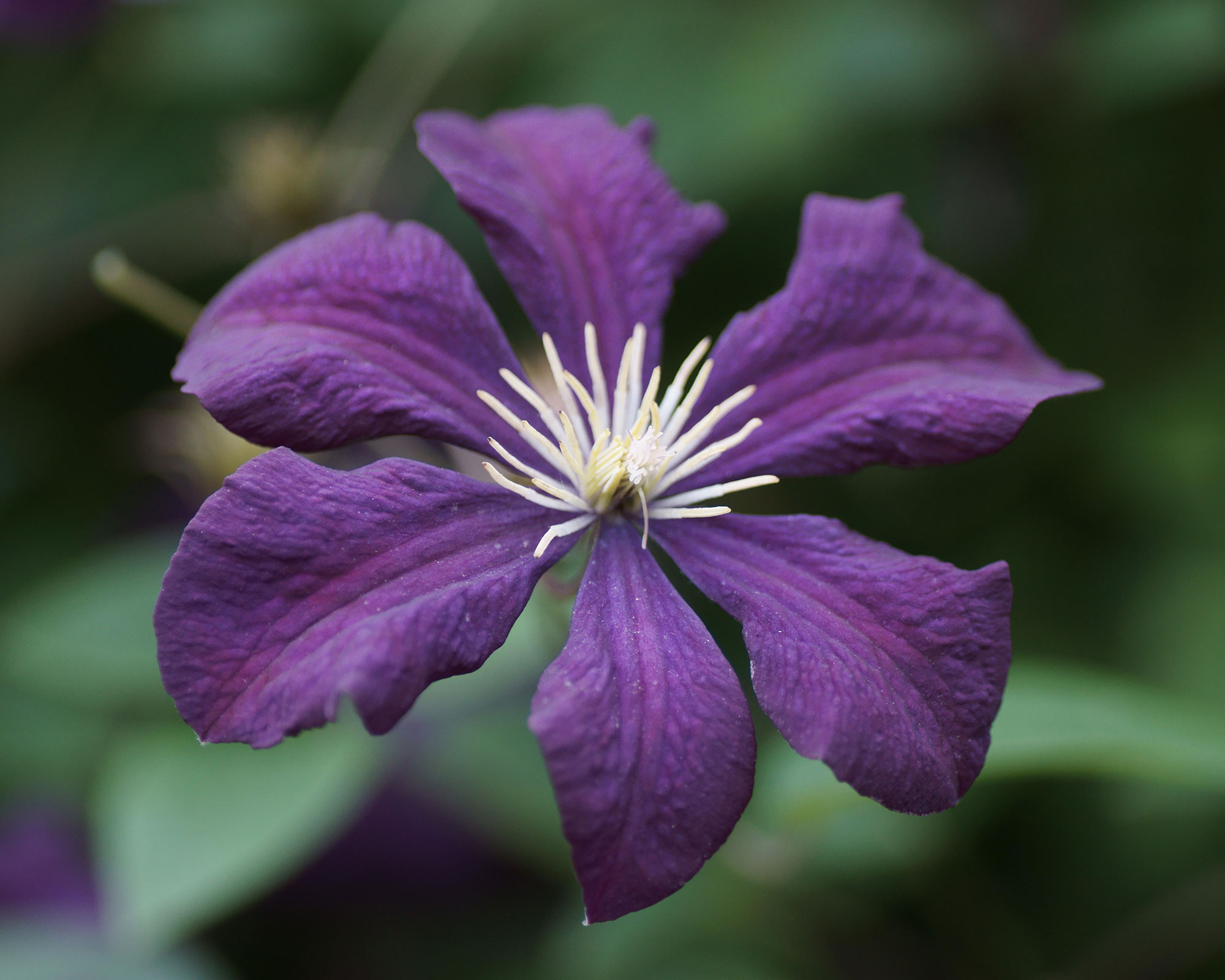
Clematis ‘Étoile Violette’ flowers profusely from early summer
What goes with purple flowers in the garden?
Blue, pink, yellow, and orange flowers, as well as claret, gold, and silver foliage plants will all complement purple flowers. A single patch of dark regal-purple can stand out too much, so it can be better to dot it through a border and pair it with complementary colors, such as lavender or gold.

The garden was always a big part of Holly's life growing up, as was the surrounding New Forest where she lived. Her appreciation for the great outdoors has only grown since then. She's been an allotment keeper, a professional gardener, and a botanical illustrator – plants are her passion.
